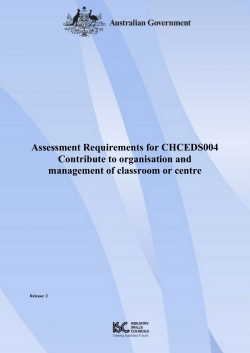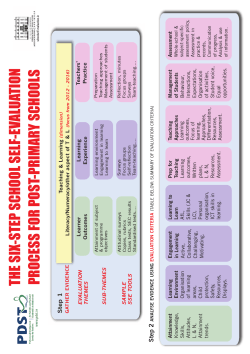
Introduction to the Employment Services 2015 Business Adjustment
INTRODUCTION INTRODUCTION TO THE EMPLOYMENT SERVICES 2015 BUSINESS ASSISTANCE PACKAGE PART OF A MODULAR TRAINING RESOURCE © Commonwealth of Australia 2015 With the exception of the Commonwealth Coat of Arms and where otherwise noted all material presented in this document is provided under a Creative Commons Attribution 3.0 Australia (website) licence. The details of the relevant licence conditions are available on the Creative Commons website (accessible using the links provided) as is the full legal code for the CC BY 3.0 AU licence. Disclaimer All of the material published in this Package is provided for general information purposes only. It does not constitute professional advice for any particular purpose, and the Commonwealth of Australia does not warrant or represent that it is accurate, reliable, current or complete. The material should not be relied on as the basis for any decision without users exercising their own independent skill or judgment or seeking professional advice. To the maximum extent permitted by law, the Commonwealth of Australia does not accept any legal liability or responsibility for any injury, loss or damage incurred by the use of, or reliance on, the material contained in this Package. UNDERSTANDING THE IMPACT PURPOSE OF THE PACKAGE This Chapter is the Introductory Module of the Employment Services 2015 Business Assistance Package (Package). The current contracts with providers of Job Services Australia, the New Enterprise Incentive Scheme, Harvest Labour Services and the National Harvest Labour Information Service and Work for the Dole 2014—15 Coordinators cease on 30 June 2015 subject to transition provisions. Employment Services 2015 will replace Job Services Australia from 1 July 2015. This Package is designed to offer support to current providers of employment services whose ongoing business may be significantly affected by the outcomes of the Employment Services 2015-2020 – Request for Tender (RFT) purchasing process. The Package includes tools and tips to assist you — as the Board and/or management of a Provider — to understand the implications of a tender result on the operations and future of your organisation, and to identify and address challenging business decisions as a result. 2 INTRODUCTORY MODULE This Introductory Module serves to: introduce the Package explain the contents of the Package offer a framework and tools to help you to assess the initial impact of the business change on your organisation. PACKAGE CONTENT The following diagram describes the Modules that form the whole Package. The Modules are designed to assist you to minimise weaknesses and threats and capitalise on strengths and opportunities in the context of dealing with a business change. Modules are colour coded as per the diagram below and provide practical examples and tools to assist you. M inimising w eaknesses/ Threats Capitalising strengths/ opportunities Introduction – Understanding the impact M odule 1 Understanding the financial impact M odule 6 Exploring business opportunities M odule 2 Cost optimisation M odule 7 Partnering opportunities M odule 3 Redeployment of staff M odule 4 Winding up your business M odule 5 Risk management M odule 8 Writing a strong tender M odule 9 Business Planning M odule 10 – M anaging change and communication M odule 11 – Summary module, tools and templates 3 ACRONYMS AND ABBREVIATIONS Included below is a list of acronyms and abbreviations that are used throughout the Package. Acronym Description ASIC Australian Securities and Investments Commission CEO Chief Executive Officer Corporations Act Corporations Act 2001 DHS Department of Human Services DIS Department of Industry and Science DoH Department of Health DVA Department of Veterans’ Affairs FEG Fair Entitlements Guarantee FBT Fringe Benefits Tax FTE Full-Time Equivalent HR Human Resources IT Information Technology KPI Key Performance Indicator MVL Members’ Voluntary Liquidation NES National Employment Standards NFP Not-For-Profit Organisation NGO Non-Government Organisation (which may include For-Profit and Not-For-Profit Organisations) Package Refers to the Employment Services 2015 Business Assistance Package PBI Public Benevolent Institution PESTLE Political, Economic, Social, Technological, Legal and Environmental RFT Request for Tender RTO Registered Training Organisation RJCP Remote Jobs and Communities Programme 4 Acronym Description SWOT Strengths, Weaknesses, Opportunities and Threats This Module assists you to assess the immediate impact of a business change on your organisation, and to map what key decisions you might need to make. Understanding the relative importance of the change is a good place to start. You may face varying degrees of challenge as a result of the Employment Services 2015 – 2020 RFT outcomes. The Business Result Matrix below can be used to map where your organisation might be sitting. BUSINESS RESULT MATRIX Where would you map your organisation on this matrix? Managing the impact of a business change is difficult for any organisation, and tests leadership and staff in many ways. An organisation sitting in quadrant 4 might be faced with the issue of having to wind up their organisation, whereas an organisation in quadrant 1 might be seeking new business opportunities from other sources. Strategies to deal with these scenarios are introduced in Modules 1–10. Another way to assess the impact is to quantify the revenue change to your business. 5 What percentage of revenue has your business lost? Depending on how your organisation is placed, you might be faced with a number of important decisions, some which need to be made immediately and others over the coming six months. The diagram below considers some of those areas of your business that need to be considered in this decision-making process. Many of these areas will need to be considered at the same time to create a holistic picture. As an initial starting point to focus your decision-making, consider a high-level SWOT analysis. A SWOT analysis can be used to identify and classify key strategic factors. The word SWOT is an acronym for Strengths, Weaknesses, Opportunities and Threats. The purpose of a SWOT is to: assess the current situation. develop goals and objectives. evaluate strategic options. identify barriers to growth or change. 6 A SWOT analysis is a quick tool, which can be used to organise your thinking around a wide range of issues your business might currently be facing. For an example of a SWOT analysis matrix, see page 4 of Module 9. The Modules in this Package are designed to assist you to address and manage potential ‘weaknesses and threats’ and assist you in exploring and capitalising on ‘opportunities and strengths’ for your business. The Modules have been structured along these two themes as demonstrated on page 3 of this Introductory Module. The Modules can be summarised as follows: Modules 1–5 address ‘weaknesses and threats’. Modules 6–9 address ‘strengths and opportunities’. Module 10 addresses change management and communication strategies. Module 11 summarises the Package and includes blank tools and templates referred to throughout the Package. The SWOT analysis framework is used throughout the Package as a quick tool to map business issues and to help collate the range of issues your organisation may be faced with. The following table further explores questions you might need to consider while assessing the impact of the business change. This will also assist you to communicate to those stakeholders relevant to your business such as your Board, staff, employers, job seekers, other funding agencies and the Department of Employment. This range of questions is an alternate means of triggering and teasing out the range of issues your organisation might be facing. These questions are all addressed in the following Modules to assist with understanding how the SWOT analysis framework can be used to manage the impact of business change. Impact Issues and questions to explore Strategic/Governance Does the Board understand the impact on the business? Is there a plan to consider a new strategy moving forward? Are there other business partners that might assist you? In the worst case scenario is insolvency a potential issue? Is a transition plan required to manage the six-month transition period? This might include a people strategy and understanding of existing contracts (leases, other 7 Impact Issues and questions to explore service contracts, etc.). Financial Regulatory Business Model People and Culture 8 What are the potential risks (for example, key staff leaving)? Is the financial impact understood? Is this understood for the transition period (April 2015 to June 2015) and then beyond July 2015? Has a new budget been developed? Can new revenue streams be explored? Can costs be optimised in the short term and longer term? If redundancies are required, do you understand the true costs? Do you understand your employment contracts and the industrial relations environment you need to adhere to? Do you understand the taxation environment in relation to redundancies? Do you understand your obligations under your overarching operating environment (for example, Incorporated Association Act, Constitution, Company Act), particularly in relation to insolvency or voluntary wind up? What is the impact on your business model? What is the impact on delivery sites? What is the impact on aligned services that you may offer? How are you communicating the impact to staff? If staff are impacted, how can you support them to find alternate employment? Impact 9 Issues and questions to explore How is the change management process being managed? Do you understand the transition process for Employment Services 2015 and the impact on job seekers?
© Copyright 2025









